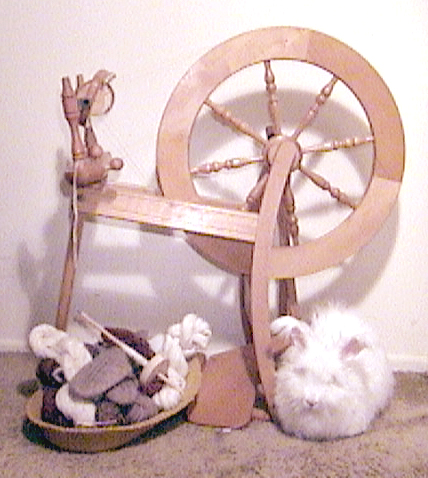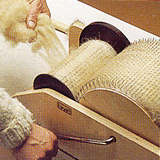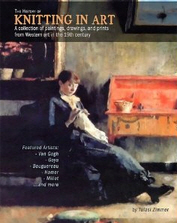Handspinning is the art of twisting fiber, fleece, or roving of wool and various natural fibers into a continuous thread/yarn. Traditional tools for handspinning are spinning wheels and drop spindles. The yarn created is for knitting, weaving, and fiber art projects.
Here you will find all the information you need to teach yourself the art of handspinning yarn. Joy of Handspinning includes several video demonstrations to assist you in learning various handspinning techniques, along with articles of helpful information. The information we’ve learned along the way consists of traditional and contemporary approaches. Our primary goal is to share with you the joy of handspinning fiber into yarn.
A Brief History of Handspinning
Handspinning, the art of using spinning tools to transform fibers into yarn, has been practiced for millennia. Early evidence dates back to ancient civilizations like Egypt, the Middle East, and Indus Valley. Individuals used simple drop spindles to transform wool, flax, and cotton into yarn.
Handspinning was once an essential element of Europe and Asia’s economies during the Middle Ages as demand for textiles surged with trade expansion and urbanization. Handspinners, often women and children, worked long hours on spinning wheels to provide enough yarn for weavers and textile workers. However, due to the industrial revolution of the 18th and 19th centuries, handspinning gradually gave way to mechanized spinning methods, which were faster and more efficient, although handspinning remains a popular hobby today worldwide.











 If you would like to learn how to spin, but buying a wheel just isn’t in your budget. Then here’s an easy and economical way
to make you own drop spindle. Go to a craft shop that sells wooden products and buy a wooden car wheel about 2-3 inches in diameter, this will be the whorl part of the spindle. The wheel has already been drilled with a hole in the exact center which will keep the spindle from wobbling when it spins.
Next you need to find a dowel rod that will fit snugly in the center hole of the wheel. This will be the shaft of your spindle. The dowel rods are 3 feet long when you purchase them. I cut my shaft at 9 or 12 inches, so 3 or 4 spindles can be made with one dowel rod.
If you would like to learn how to spin, but buying a wheel just isn’t in your budget. Then here’s an easy and economical way
to make you own drop spindle. Go to a craft shop that sells wooden products and buy a wooden car wheel about 2-3 inches in diameter, this will be the whorl part of the spindle. The wheel has already been drilled with a hole in the exact center which will keep the spindle from wobbling when it spins.
Next you need to find a dowel rod that will fit snugly in the center hole of the wheel. This will be the shaft of your spindle. The dowel rods are 3 feet long when you purchase them. I cut my shaft at 9 or 12 inches, so 3 or 4 spindles can be made with one dowel rod.
 There are several brands of spinning wheel on the market today. Although they have different names, they basically follow the traditional styles of spinning wheel from the past. The Saxony wheel is the most popular style of wheel for beginners, while the Great Wheel is generating new interest from advanced handspinners.
There are several brands of spinning wheel on the market today. Although they have different names, they basically follow the traditional styles of spinning wheel from the past. The Saxony wheel is the most popular style of wheel for beginners, while the Great Wheel is generating new interest from advanced handspinners.
 Choosing a good fleece for handspinning can be tricky for a beginner. Many breeders are willing to sell you their fleeces, in some cases, even give it away. But not all fleeces are suitable for handspinning, and you may lose your enthusiasm for handspinning raw fleece if your first fleece is a bad one.
Choosing a good fleece for handspinning can be tricky for a beginner. Many breeders are willing to sell you their fleeces, in some cases, even give it away. But not all fleeces are suitable for handspinning, and you may lose your enthusiasm for handspinning raw fleece if your first fleece is a bad one.
 Angora rabbits are relatively easy to care for. They don’t require vaccinations, and it doesn’t cost much to feed them. Keeping them well groomed is the biggest chore in order to maintain a coat of fur that is matt-free and clean. I wouldn’t recommend adopting an Angora rabbit if you are not willing to take the time to thoroughly brush or blow out their coats at least twice a week. Although, I have found that my German angoras require less grooming, which is why they are my favorite breed.
Angora rabbits are relatively easy to care for. They don’t require vaccinations, and it doesn’t cost much to feed them. Keeping them well groomed is the biggest chore in order to maintain a coat of fur that is matt-free and clean. I wouldn’t recommend adopting an Angora rabbit if you are not willing to take the time to thoroughly brush or blow out their coats at least twice a week. Although, I have found that my German angoras require less grooming, which is why they are my favorite breed.
 Using a drum carder is another way of preparing your fiber for spinning. Its more efficient than hand-carding, allowing you to card larger amounts at one time. It is best to use fleece that has been pre-washed, because it cards easier and puts less wear on the machine. The drum carder can also be used for making fiber blends and working with colored fibers.
Using a drum carder is another way of preparing your fiber for spinning. Its more efficient than hand-carding, allowing you to card larger amounts at one time. It is best to use fleece that has been pre-washed, because it cards easier and puts less wear on the machine. The drum carder can also be used for making fiber blends and working with colored fibers.

